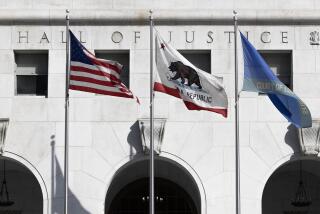O.C. grand jury says claims of an illegal jailhouse informant program are a ‘myth’

For years, accusations that Orange County prosecutors and sheriff’s deputies ran a secret program that used jailhouse informants to obtain confessions from criminal defendants have dogged some of the area’s top law enforcement leaders.
The informant scandal has sparked a retrial in at least one murder case, and stalled the proceedings against a man who confessed to gunning down eight people in Seal Beach.
On Tuesday, however, the county’s grand jury dismissed the entire scandal as a “myth,” releasing the findings of a months-long investigation that was hailed as vindication by prosecutors and dismissed as a whitewash by defense attorneys.
In a 28-page report, the grand jury said critics and media outlets had blown the scandal out of proportion after it became central to the case of Scott Dekraai, who has admitted he walked into a Seal Beach hair salon and fatally shot eight people in 2011.
Grand jurors found no evidence that prosecutors or the Sheriff’s Department had used “mercenary informants” — snitches who are provided with favors or valuables to solicit information from a specific inmate — to obtain confessions from defendants.
“Although the use of in-custody informants does occur, it is generally organic in nature, case specific and does not represent a conspiracy,” the report said.
Sheriff Sandra Hutchens and Dist. Atty. Tony Rackauckas, who have both faced intense criticism over the controversy, responded by saying the grand jury had validated what both had repeatedly said before.
But the report stands in stark contrast to allegations leveled by Dekraai’s attorney and findings by Superior Court Judge Thomas Goethals, who is presiding over Dekraai’s trial. Goethals has said he is “satisfied beyond any doubt” that the Sheriff’s Department had a program that placed informants next to inmates with the aim of coaxing confessions out of them — a practice the law forbids. An appellate court has also determined that the Sheriff’s Department was running a “sophisticated” informant program in the jails.
Dekraai’s attorney, Orange County Assistant Public Defender Scott Sanders, criticized the report, saying grand jurors had failed to understand the scale of the jailhouse informant problem and that their findings broke with rulings handed down by several sitting judges.
“We don’t think this is particularly good work by the grand jury here,” he said. “They are taking on the judge, the court of appeals, who’ve all decided this is systemic issue. It is kind of an embarrassing effort.”
The U.S. Department of Justice and the California attorney general’s office are conducting separate investigations into the scandal.
The scandal exploded in 2015, when Goethals removed the district attorney’s office from Dekraai’s case after Sanders argued that authorities intentionally placed Dekraai in a cell near a well-known informant. The case is now being prosecuted by the state attorney general’s office.
Dekraai, a former tugboat captain, has pleaded guilty to murdering his ex-wife and the seven other victims in the salon shooting. But the informant scandal has delayed proceedings to determine whether he will face the death penalty. Dekraai’s attorney has argued that the death penalty should be tossed out because authorities cannot be trusted to turn over relevant evidence.
Sanders contends that jailhouse informants and their handlers have violated the rights of inmates for years by coaxing information from defendants who are represented by lawyers. An appellate court upheld Goethals’ decision to remove the district attorney’s office from Dekraai’s case, adding that sheriff’s deputies were clearly moving informants around the jail to place them near specific inmates.
The [grand jury] found no direct, material evidence of an organized, recognized ‘program’ of jailhouse informants.
— Orange County grand jury report
Defense attorneys in other cases have since argued that prosecutors failed to disclose information about the use of informants during discovery, which would violate their clients’ rights.
Last year, the fallout of the so-called snitch scandal led Goethals to order a retrial for an Anaheim man who was convicted of aiding in the 1998 murder of a pregnant woman. An informant’s testimony was used against the man at a 2006 trial, but a defense attorney argued prosecutors had failed to disclose information about the witness’ history as an informant.
In Dekraai’s case, the informant was a former shot-caller in the Mexican Mafia who had become a prolific informant in the hopes of gaining a reduced sentence. Fernando Perez was facing 40 years to life in prison for a weapons charge but ultimately received a reduced sentence and could be freed in less than seven years.
Arguing that the scandal goes far beyond Dekraai’s case, Sanders has said the Sheriff’s Department intentionally hid logs documenting the movements of known informants inside the jails.
The grand jury report, however, said the logs did not show collusion between prosecutors and sheriff’s officials.
“The contents of this log shed little light on Dekraai’s movements while in-custody,” the grand jury wrote. “It would seem that it was the failure to disclose the Log, rather than the actual contents, that created much of the angst.”
The grand jury report also dismissed the housing assignments of Dekraai and the informant as “coincidental.”
“There are only a small number of cells for high-profile or special custody inmates, and both the informant and Dekraai would have needed to be placed in protective custody. The placement of Dekraai was reasonable within this context,” the grand jury wrote.
The report said the existence of informants in the jail did not lend any credence to allegations that they were being actively cultivated or moved around the jails by county law enforcement. The use of informants by the Sheriff’s Department is normally limited to gathering intelligence that would preserve the security of the jails, rather than investigating crimes, the report said.
“The [grand jury] found no direct, material evidence of an organized, recognized ‘program’ of jailhouse informants,” the report said.
In instances when investigators or prosecutors failed to provide defense attorneys with information about a jailhouse informant’s background of cooperating, the grand jury placed the blame on a lack of supervision rather than a concerted effort to deny defendants their constitutional rights.
The majority of cases involving informants given favors or leniency for cooperation were run by other law enforcement agencies, according to the report, which cited a number of informant-driven gang investigations run by the Anaheim Police Department. Anaheim police used two such jailhouse informants to bring nearly 30 cases to the district attorney’s office, grand jurors wrote.
Rackauckas has scoffed at allegations that his office was engaged in any misconduct and has pointed to the rarity in which informants’ testimony is used at trial. In 2015, the district attorney’s office filed 8,600 felony cases, but jailhouse informants were used in only three cases, he said last year.
Rackauckas released a statement Tuesday praising the grand jury report, which he said debunked a “media witch hunt” targeting his office.
“This controversy was created by a public defender desperate to spare a mass murderer the death penalty after the [prosecutors] secured the guilty plea and, at a minimum, a sentence of life without the possibility of parole,” he said in the statement. “The media, despite being presented with the truth on multiple occasions by the [district attorney’s office], reported whatever the public defender said, which was then parroted by law professors and retired politicians without doing any investigation.”
In a separate statement, the Sheriff’s Department said it hoped the report would put an end to the allegations surrounding the snitch scandal, and hoped Dekraai’s case would finally move forward.
For more breaking crime and cops news in Southern California, follow us on Twitter: @JamesQueallyLAT and @lacrimes
UPDATES:
6:45 p.m.: This story was updated with additional information from the grand jury report and previous court decisions related to the scandal.
4:55 p.m.: This story was updated with additional comments from Rackauckas, Sanders and additional details from the grand jury report.
This story first published at 11:50 a.m.
More to Read
Sign up for Essential California
The most important California stories and recommendations in your inbox every morning.
You may occasionally receive promotional content from the Los Angeles Times.












